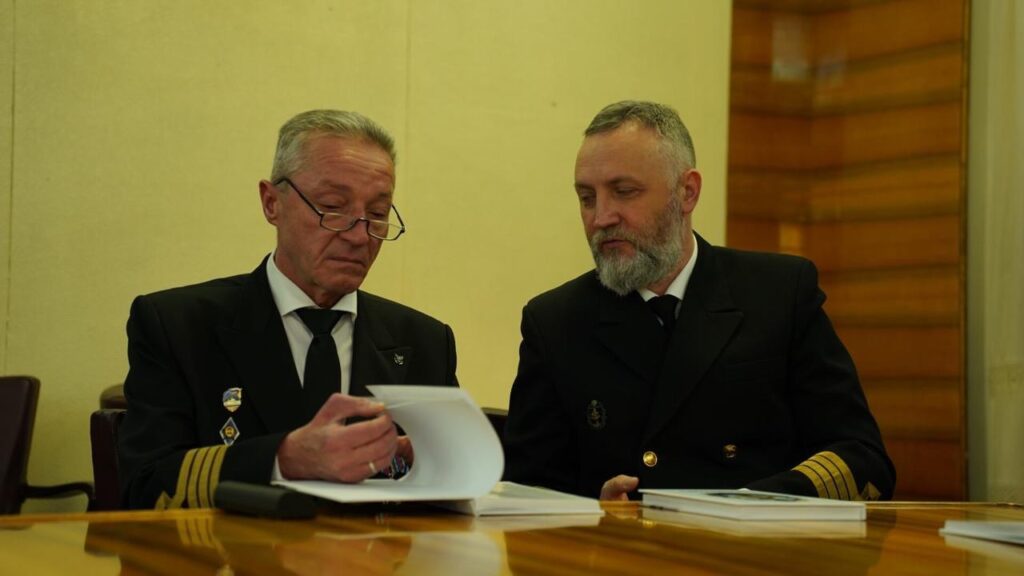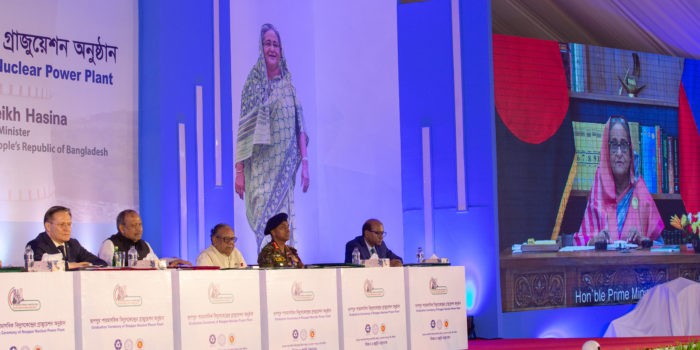Anniversary events dedicated to the Day of the Russian Nuclear-Powered Icebreaker Fleet and the 65th anniversary of the country's icebreaker fleet were held on December 3 in Murmansk, hosted by FSUE Atomflot (Rosatom State Corporation enterprise).
A meeting of Atomflot employees and an award ceremony for seamen and shore-based personnel was held in celebration of the holiday. It was attended by Andrei Chibis, Governor of the Murmansk Region, Sergey Dubovoy, Chairman of the Murmansk Regional Duma, Boris Kabakov, Director of the Department of Project Implementation in the NSR and Arctic of the Arctic Directorate of Rosatom State Corporation, and Yakov Antonov, Head of FSUE Atomflot.
Boris Kabakov, Director of the Department of Project Implementation in the NSR and Arctic of the Arctic Directorate of Rosatom State Corporation, read out the welcoming address from Alexey Likhachev, Director General of Rosatom State Corporation. It stated in particular as follows: “FSUE Atomflot meets its 65th anniversary as an efficient and dynamically developing enterprise. Three new nuclear-powered icebreakers have already been commissioned, and the Yakutia nuclear-powered icebreaker will join the fleet very soon. Four more vessels, including the Rossiya heavy-duty icebreaker, are under construction. But the most important thing that makes Atomflot proud is its crew, brave polar seamen who conquer the Arctic every day. There are no other people with such knowledge and experience in any other country in the world.”
“We are proud that our Murmansk is the home port of all nuclear-powered icebreakers. It's thoroughly consistent with the city character. Given active development of the Northern Sea Route, given the tasks set by the President on developing this most important transportation route for the world trade and, of course, for our country, the nuclear-powered icebreaker fleet represents our competitive advantage. It is great that our country is not just maintaining what was created earlier, but is moving forward actively. Breaking and crushing ice, ensuring transportation of the most important cargoes, and setting new records along the Northern Sea Route. And I am convinced that it will continue to be so!”, Andrei Chibis said.
“This is a great year when we can say clearly that transition from icebreakers of the past generation to 22220 icebreakers of a completely new generation has taken place,” Yakov Antonov emphasized. “There is demand for our services. And, most importantly, there is clear support from our partners. When you understand and see the significance of our services and their relevance, it lifts your spirits and strengthens seamen's confidence in the future.”

The anniversary program aboard the Lenin nuclear-powered icebreaker was opened by presentation of the book “Polar Captains” by Vladimir Blinov, the fleet historian. The basis of the semi-fiction collection is formed by diary entries, reflections of famous captains, as well as literary compositions of writers and seamen. The publication was supported by FSUE Atomflot. The program of events dedicated to the 65th anniversary of the nuclear-powered icebreaker fleet ended with the festive lighting of the Lenin nuclear-powered icebreaker and a performance by Uma2rman band.
Reference
In 2018, the Russian Government authorized Rosatom as the infrastructure operator of the Northern Sea Route (NSR). The corporation supervises the federal project “Development of the Northern Sea Route”, as well as takes part in implementing the Northern Sea Route Development Plan until 2035 and the initiative for socio-economic development of the Russian Federation until 2030, “All-Year-Round Northern Sea Route”, approved by the Russian Government. One of Rosatom's strategic objectives consists in making the NSR an efficient passage connecting Europe, Russia, and the Asia Pacific Region. A federal project is currently being prepared to develop the Great Northern Sea Route – the transport corridor from St. Petersburg and Kaliningrad to Vladivostok.
The official date of foundation of the nuclear-powered icebreaker fleet is December 3, 1959. On this day, the ceremony of raising the national flag on the world's first nuclear-powered icebreaker, Lenin, took place.
In 2008, the Atomflot Federal State Unitary Enterprise became a part of the State Corporation Rosatom based on the Decree of the President of the Russian Federation “On Measures to Establish the State Atomic Energy Corporation Rosatom” (No. 369 dated March 20, 2008). Since August 28, 2008, nuclear-powered vessels and nuclear maintenance ships have been transferred to FSUE Atomflot. The main company activities involve icebreaker support of the largest Arctic investment projects; icebreaker escorting of vessels in the waters of the Northern Sea Route and to freezing ports of the Russian Federation; provision of a range of port fleet services in the port of Sabetta; transportation of cargoes by the Sevmorput nuclear-powered container ship; safe handling of nuclear materials and radioactive waste. In addition, Rosatomflot participates in the environmental rehabilitation of the North-West region of Russia. Due to peculiarities of propulsion systems, one of the technical challenges consists in ensuring safe handling of nuclear materials and radioactive waste.
The nuclear-powered icebreaker fleet currently includes: Arktika, the lead universal nuclear-powered icebreaker, Siberia, the first serial universal nuclear-powered icebreaker, Ural, the second serial universal nuclear-powered icebreaker with a capacity of 81.500 hp, two nuclear-powered icebreakers with a capacity of 75.000 hp (Yamal, 50 Let Pobedy), two icebreakers with a capacity of about 50.000 hp (Taimyr, Vaigach), Sevmorut, the nuclear-powered container ship with a capacity of 40.000 hp. In addition to the nuclear-powered icebreaker fleet, Rosatomflot operates some maintenance ships and port fleet vessels designed to service the waters of the port of Sabetta.
The comprehensive development of Russia's Arctic territories is a strategic priority for the Russian State. Expanding the traffic volume of the Northern Sea Route is of paramount importance for meeting the cargo delivery targets. We arrange regular cargo traffic, build new nuclear-powered icebreakers, and update the infrastructure to expand this logistic corridor. Rosatom's enterprises are contributing heavily to this endeavor.





